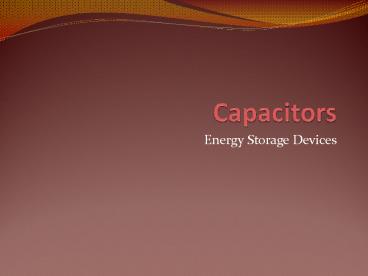Capacitors PowerPoint PPT Presentation
1 / 25
Title: Capacitors
1
Capacitors
- Energy Storage Devices
2
Objective of Lecture
- Describe the construction of a capacitor and how
charge is stored. - Introduce several types of capacitors
- Discuss the electrical properties of a capacitor
- The relationship between charge, voltage, and
capacitance - Charging and discharging of a capacitor
- Relationship between voltage, current, and
capacitance power and energy - Equivalent capacitance when a set of capacitors
are in series and in parallel
3
Capacitors
- Composed of two conductive plates separated by an
insulator (or dielectric). - Commonly illustrated as two parallel metal plates
separated by a distance, d. - C e A/d
- where e er eo
- er is the relative dielectric constant
- eo is the vacuum permittivity
4
Effect of Dimensions
- Capacitance increases with
- increasing surface area of the plates,
- decreasing spacing between plates, and
- increasing the relative dielectric constant of
the insulator between the two plates.
5
Types of Capacitors
- Fixed Capacitors
- Nonpolarized
- May be connected into circuit with either
terminal of capacitor connected to the high
voltage side of the circuit. - Insulator Paper, Mica, Ceramic, Polymer
- Electrolytic
- The negative terminal must always be at a lower
voltage than the positive terminal - Plates or Electrodes Aluminum, Tantalum
6
Nonpolarized
- Difficult to make nonpolarized capacitors that
store a large amount of charge or operate at high
voltages. - Tolerance on capacitance values is very large
- 50/-25 is not unusual
PSpice Symbol
http//www.marvac.com/fun/ceramic_capacitor_codes.
aspx
7
Electrolytic
- Pspice Symbols
- Fabrication
http//www.digitivity.com/articles/2008/11/choosin
g-the-right-capacitor.html
8
Variable Capacitors
- Cross-sectional area is changed as one set of
plates are rotated with respect to the other.
PSpice Symbol
http//www.tpub.com/neets/book2/3f.htm
9
MEMS Capacitor
- MEMS (Microelectromechanical system)
- Can be a variable capacitor by changing the
distance between electrodes. - Use in sensing applications as well as in RF
electronics.
http//www.silvaco.com/tech_lib_TCAD/simulationsta
ndard/2005/aug/a3/a3.html
10
Electric Double Layer Capacitor
- Also known as a supercapacitor or ultracapacitor
- Used in high voltage/high current applications.
- Energy storage for alternate energy systems.
http//en.wikipedia.org/wiki/FileSupercapacitor_d
iagram.svg
11
Electrical Properties of a Capacitor
- Acts like an open circuit at steady state when
connected to a d.c. voltage or current source. - Voltage on a capacitor must be continuous
- There are no abrupt changes to the voltage, but
there may be discontinuities in the current. - An ideal capacitor does not dissipate energy, it
takes power when storing energy and returns it
when discharging.
12
Properties of a Real Capacitor
- A real capacitor does dissipate energy due
leakage of charge through its insulator. - This is modeled by putting a resistor in
- parallel with an ideal capacitor.
13
Energy Storage
- Charge is stored on the plates of the capacitor.
- Equation
- Q CV
- Units
- Farad Coulomb/Voltage
- Farad is abbreviated as F
14
Sign Conventions
- The sign convention used with a capacitor is the
same as for a power dissipating device. - When current flows into the positive side of the
voltage across the capacitor, it is positive and
the capacitor is dissipating power. - When the capacitor releases energy back into the
circuit, the sign of the current will be negative.
15
Charging a Capacitor
- At first, it is easy to store charge in the
capacitor. - As more charge is stored on the plates of the
capacitor, it becomes increasingly difficult to
place additional charge on the plates. - Coulombic repulsion from the charge already on
the plates creates an opposing force to limit the
addition of more charge on the plates. - Voltage across a capacitor increases rapidly as
charge is moved onto the plates when the initial
amount of charge on the capacitor is small. - Voltage across the capacitor increases more
slowly as it becomes difficult to add extra
charge to the plates.
16
Adding Charge to Capacitor
- The ability to add charge to a capacitor depends
on - the amount of charge already on the plates of the
capacitor - and
- the force (voltage) driving the charge towards
the plates (i.e., current)
17
Discharging a Capacitor
- At first, it is easy to remove charge in the
capacitor. - Coulombic repulsion from charge already on the
plates creates a force that pushes some of the
charge out of the capacitor once the force
(voltage) that placed the charge in the capacitor
is removed (or decreased). - As more charge is removed from the plates of the
capacitor, it becomes increasingly difficult to
get rid of the small amount of charge remaining
on the plates. - Coulombic repulsion decreases as charge spreads
out on the plates. As the amount of charge
decreases, the force needed to drive the charge
off of the plates decreases. - Voltage across a capacitor decreases rapidly as
charge is removed from the plates when the
initial amount of charge on the capacitor is
small. - Voltage across the capacitor decreases more
slowly as it becomes difficult to force the
remaining charge out of the capacitor.
18
Current-Voltage Relationships
19
Power and Energy
20
Capacitors in Parallel
21
Ceq for Capacitors in Parallel
22
Capacitors in Series
23
Ceq for Capacitors in Series
24
General Equations for Ceq
- Parallel Combination
- Series Combination
- If P capacitors are in parallel, then
- If S capacitors are in series, then
25
Summary
- Capacitors are energy storage devices.
- An ideal capacitor act like an open circuit at
steady state when a DC voltage or current has
been applied. - The voltage across a capacitor must be a
continuous function the current flowing through
a capacitor can be discontinuous. - The equations for equivalent capacitance for
- capacitors in parallel capacitors
in series

